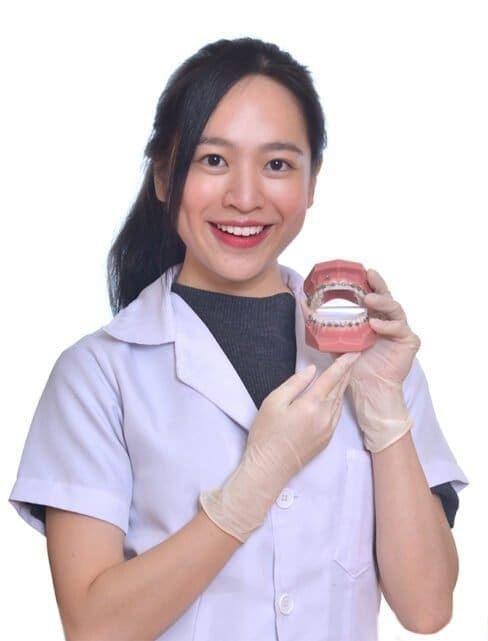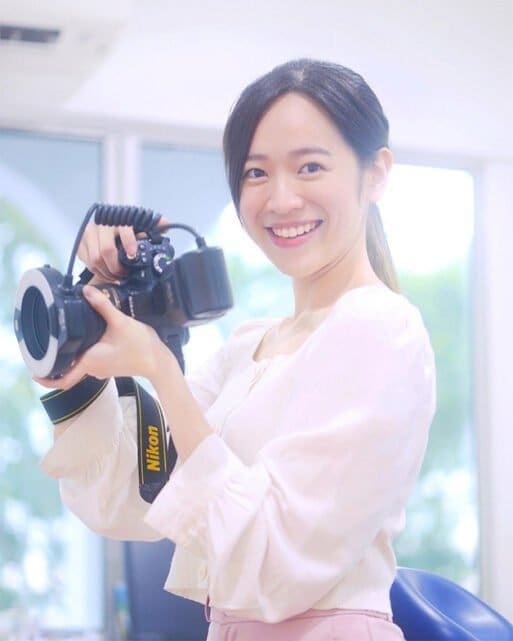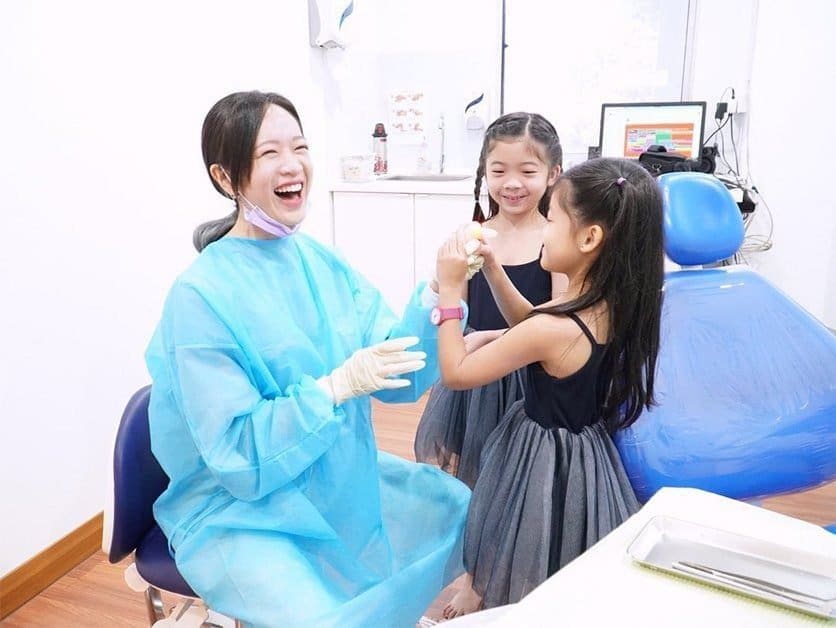Malaysia’s rising dentist celebrity walks a fine line between education and entertainment in her buzzy dental videos.
By Danny Chan
If you’ve been trawling YouTube or Instagram for dental-related stuff lately, chances are, you would have come across Dr Kayla Teh – or Dr Kayla, as she is affectionately known online.
In recent months, the bubbly Malaysian dentist has experienced a meteoric rise in popularity. Basically, she has gained enough viewers and social clout to qualify as what people today would call a ‘dent-fluencer’ – a catch-all term describing a crop of post-COVID dentists and hygienists hopping on social media to share their expertise on everything teeth-related.
Of course, Dr Teh would remind you that she started her video-sharing journey in 2018 – before the pandemic descended and forced many closet YouTubers out of the woodwork.

Impressive numbers
Dr Teh’s exuberant take on anything from braces to her clinic’s pink cabinets has attracted swarms of netizens and clicks, not to mention animated comments from a growing viewership and fan base.
A casual flick through her YouTube playlist finds a decent crop of videos over the 100K-viewership mark – some even crossing the coveted 500K threshold. Her Instagram Reels draw an average of 60K viewers. Mind you, these are pretty impressive figures for video channels that revolve around fixing teeth.
Chalking up 27.9K followers on Facebook, 38.4K subscribers on YouTube and 80.6K on Instagram, the Internet personality is trending well enough to be featured on TedX talk and even have her courtship story (she got engaged recently) become a newsy item.
Practice-building journey
When Dr Teh began her own practice about 5 months ago, the savvy marketer chronicled the transformation of her dentist office from an empty building to the final renovation, explaining her fit-out motivations and decisions along the way.

In characteristic candour, the easy-going dental influencer reveals that almost all of her patients found out about the new practice through one of her social media outlets.
Some of her dental customers travel to visit her clinic from as far as neighbouring Singapore as well as Sarawak and Sabah, Western Malaysian states located a short flight away.
Such is the power of social media and Dr Teh’s engaging personality that has endeared the rising dental star to hordes of ardent followers.
In this Q&A with Dental Resource Asia, the young owner and principal dentist of Dr Kayla Dental Clinic shares her passion for delivering educational dental vids with a blend of authority and authenticity.
She also opens up about her exhausting routines; juggling a full time job while being the star of her namesake media channels.
Dental Resource Asia: What made you start posting dental videos on social media platforms?
Dr Kayla Teh: I actually started back in 2018 after graduating with a BDS. You know, that’s when you start to get “dentistry-related” questions from friends like “what’s the correct way to brush my teeth” and basic stuff like that.
I thought to myself, if I were to post a Q&A-type dental video on social media, I could just tell other friends who have similar questions to check it out.
So I posted my first video, thinking who knows, maybe others out there in cyberspace could also benefit from that information. As it turned out, that video actually caught on, and people online started asking for my advice on a host of dental topics.
I responded with another video, and then another one, and here I am, still doing it four years later.
DRA: Did you have any video-making experience back then?
KT: In a way. I have friends who are videographers and photographers. I sometimes get asked to be a model for their projects – and usually I’d do it for fun. So I ended up gaining a bit of shooting experience and learning how to present myself in front of the camera.
Of course, I also started doing some research when I got serious about making my own videos, reading up on the latest cameras and audio recording gear and so on.
I was editing all my videos back then. After it got a bit too much to handle, I started outsourcing the work. I still write all my scripts because I always want to make sure that the information is 100% accurate. The last thing I want is to misrepresent my profession or provide misleading information to the public.

DRA: You seem to treat these videos as some sort of a public service good, at least in the informational sense.
KT: Funny you should say that, because I actually did some work with the Healthcare Ministry of Malaysia. We produced a series of dental awareness content catering to the Malaysian public.
That also reminds me of another reason for making educational videos, which is how I would describe my videos.
In my uni days, I volunteered for an outreach program providing dental and medical services to patient communities in the rural parts of Malaysia.
I attended to a child with cleft lip and palate. His parents were unaware that the condition could actually be surgically corrected, especially if treated at a young age. When I heard that the kid was made fun of in school due to the condition, it made me think hard about what I could do in my limited capacity to help spread the knowledge.
If any of my videos could help fill an information void or point someone in the right direction to seek dental treatment or help, I think that alone would be a great achievement.
A lot of these rural residents have access to the Internet, but much of the information available online is presented in a very staid or serious fashion.
I believe a sincere and light-hearted approach to education works best if your goal is to reach audiences at every strata of the patient community.
It’s also important to raise the awareness and deliver the information from a professional standpoint. As a practicing dentist, I’m able to provide accurate and evidence-based information as opposed to a Regular Joe on YouTube.
By and large, my advice tends to “carry more weight” because my viewers know that I’m a dentist.

DRA: Can you share an anecdote of an encounter with one of your channel supporters?
KT: During a conference event in Penang (Malaysian state), a guy walked up to me and started thanking me for one of my videos. I had put out a video that focused on the dangers and complications of “fake veneers”, which was quite prevalent at the time.
In the video, I warned about the dangers of a dental patient visiting a beautician, or anyone who isn’t a qualified clinician, to get their veneers placed. The video also discussed about the risks and complications after placing the “fake veneers”.
Turns out the man was a dentist who had a patient visit his clinic because she had seen my video and wanted to remove her “fake veneers”.
Although this was an indirect connection with a viewer, I felt really happy about it. It didn’t matter to me whether that patient had visited my clinic or not but just the fact that I’ve made someone aware of something really important that could affect his or her health and wellbeing.
I’ve had the pleasure of meeting so many people from all walks of life who only knew of me because of my social media channels. It just makes me realise how interconnected we all are and it’s a great feeling.
DRA: Video marketing is hard enough. Making your videos go viral and finding a captive audience is even harder. How do you do it?
KT: For me, I always study the trends and what the search algorithms favour because they are ultimately responsible of directing the viewers to your platforms.
For example, I am now transitioning from long-form to short-form videos simply because current social media trends are moving in that direction. And it’s constantly changing so you have to keep up. It can be daunting at times but it is what it is.
In terms of making my videos more relevant to audiences, I always try to strike a balance between education and entertainment. For example, how do you squeeze an educational piece of information into a 10-second video and make it entertaining?
By the way, that’s the current trend and 10 seconds is the average attention span of a typical viewer these days. That’s why I stuff the bulk of the information into the description box for those who want to take a deeper dive.
In the end, you have to remember that your viewers watch your videos because of who you are. If you are faking a persona to appear more friendly or likeable to your audience, you are not going to last.
You have to treat your audience as the intelligent and highly intuitive people that they are. After a while, they can tell if you’re the real deal or just someone who is after the clicks.

DRA: Do you get flak from other dentists because of your exuberant presentation style or the celebrity profile you enjoy on social media?
KT: When I was working as a dentist in the government service – which is a mandatory posting that every fresh dental graduate in Malaysia goes through – I would hear people complain that I must have been assigned a cushy post since I still had the luxury to indulge in video productions.
That was in the beginning but I’ve since gotten used to all sorts of naysayers, especially in the comments section either denigrating my work or saying negative things like how I’m cheapening the image of the dentist profession, asking me to quit and so on.
To be honest, I found those comments rather hurtful at first. I’ve now come to the realisation that criticisms are part and parcel of any profession or industry, especially when you’re starting to get noticed and people are still unsure of where you’re coming from.
I’ll just have to let my work speak for itself and not overly concern myself with the brickbats.
DRA: Since setting up your own practice 5 months ago, where do you find the time and energy to work on your video projects?
KT: It does take a lot of time and energy, especially when you’re running a very busy practice.
For me, I have to find the discipline to commit at least one day every week to do the videos. In fact, I would be shooting content on every available off day. I haven’t had a day off since like forever!
It’s come to a point where if I have an off day and I’m not shooting new content, I would feel guilty. Sometimes after a long day of work at the clinic, I feel this pressure bubbling up in me. That’s when I know it’s time to post new content.
A commitment is a commitment. It means that even if I have to sacrifice time spent hanging out with family and friends, that’s a commitment I have to keep.
DRA: Does it affect your personal life?
KT: I have been producing content for about fours years now. The people around me, including my parents, have come to accept it as a part of my life.
I admit that it can still be a bit draining at times – especially during the initial stages of starting my own practice. I’m not an entrepreneur by nature, so had to face a huge learning curve during the set-up process. Having to pump out a constant flow of media content at the same time was definitely challenging.
Luckily, my audience are quite nice. Some of them even tried to convince me that it’s okay to take a break from social media.
That’s the good thing about creating quality content – you also attract quality audience. My viewers tend not to be the grumbly sort. They appreciate you for who you are, and understand that it takes hard work to produce quality content. So for that, I’m really grateful.
Whether it affects my personal life, well of course it does – to an extent. You wouldn’t have much time left for yourself but you really have to find the right balance yourself.
If you are convinced that it’s something worth committing to, then that’s just a sacrifice you have to make. I’ve got zero complains.
The information and viewpoints presented in the above news piece or article do not necessarily reflect the official stance or policy of Dental Resource Asia or the DRA Journal. While we strive to ensure the accuracy of our content, Dental Resource Asia (DRA) or DRA Journal cannot guarantee the constant correctness, comprehensiveness, or timeliness of all the information contained within this website or journal.
Please be aware that all product details, product specifications, and data on this website or journal may be modified without prior notice in order to enhance reliability, functionality, design, or for other reasons.
The content contributed by our bloggers or authors represents their personal opinions and is not intended to defame or discredit any religion, ethnic group, club, organisation, company, individual, or any entity or individual.

